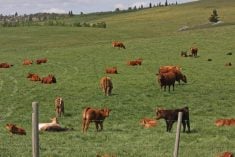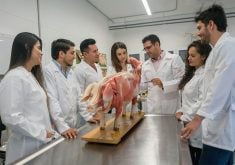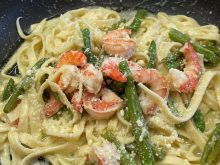We’ve had a busy time since the last article I wrote. Our daughter,
Jaime married Troy on Feb. 16 at the Mendel Art Gallery atrium with
formalities and dance to follow at the Faculty Club, University of
Saskatchewan.
This day was a reminder to me that it is important to those planning a
wedding to plan according to their own hearts, rather than follow
traditions and rituals for the sake of convention. They did it their
way, and it was perfect. Although the kids will both be 25 in April, it
Read Also

Fuel rebate rule change will affect taxes and AgriStability
The federal government recently announced updates to the fuel rebates that farmers have been receiving since 2019-20.
seems that, as parents, we too are “growing up” and into another family
life change.
Good family friends gave Jaime and Troy a treasured cookbook that
contains one of our family’s favourite salads.
Spinach and strawberry salad
Spinach
Strawberries
Tear spinach into bite-sized pieces. Cut strawberries in half. Combine
the following dressing ingredients and mix well. Toss with spinach and
strawberries.
Poppy seed Worcestershire dressing
1/3 cup white sugar 75 mL
1/2 cup oil 125 mL
1/4 cup white vinegar 50 mL
2 tablespoons sesame 30 mL
seeds
2 tablespoons poppy 30 mL
seeds
1/4 teaspoon paprika 1 mL
1/2 teaspoon 2 mL
Worcestershire sauce
1/2 teaspoon minced onion 2 mL
Source: The Best of the Best and More, from the Best of Bridge
Publishing Ltd., Centax Books.
Relaxing with yoga
We were all thankful for the Reading Week break at the U of S that
followed the wedding. As an undergraduate, I always looked at it as a
week off. As a grad student, it was a week for resting, relaxing and
reading.
One of the relaxing things I did was continue my yoga class. In each
class I have taken, I learned a little more from each yoga instructor,
as it should be.
There are varied styles of yoga, and each instructor has a different
focus. With my yoga kit including a video, a mat, blocks and belt, I
can practise at home at the farm in the spring.
According to the Keep It Simple Series Guide to Yoga by Shakta Kaur
Khalsa, archaeological discoveries have confirmed forms of yoga existed
in ancient Chinese and Mayan cultures, as well as in India and Tibet.
Yoga’s birthdate of somewhere around 2000-3000 BC has been confirmed by
reference in the Rig-Veda, which is the oldest known text in any
Indo-European language. Yoga made its debut in the western world around
the mid-1800s.
Yoga’s aim is to unite the body, mind and spirit. It aims to improve
one’s physical, mental and spiritual well-being, achieve greater
flexibility, and access new levels of personal energy and power.
Yoga gives you the tools to transform stress into energy. Practising
yoga can help you feel healthy, happy and whole.
At the end of a strong yoga set, you get the same great feeling you
experience after an intense physical exertion. It is caused by the
release of endorphins, which are natural chemicals released by the
brain that relieve pain and induce a feeling of euphoria.
To find out more about yoga, check out the website www.yogamovement.com
created for both beginners and experienced yoga practitioners.
About breathing
Breathing is the first thing we do when we come into life and the last
thing we do on leaving it. In between, most of us are often not aware
that we are breathing. Taking the unconscious process of breathing and
making it conscious is an essential aspect of yoga.
Shallow breathing, where only the tops of the lungs are filled with
oxygen, deprives the body of vitality. With yogic breathing, the lungs
are filled completely and the diaphragm is fully engaged.
In one of my educational psychology classes, we are studying the
benefits of abdominal breathing as opposed to chest breathing or
over-breathing. Hyperventilation can be a habit learned in childhood or
a reaction to prolonged stress.
You need to breathe, but if you breathe too much, you can experience a
range of uncomfortable physical and psychological symptoms such as
chest pain, lightheadedness, a feeling of impending disaster,
palpitations, tightness in scalp and neck, numbness of the limbs,
tingling, burning or itching sensations and even panic attacks.
Maxine South of Prairie Therapists and Trainers, Inc. worked with our
class to practise the following breathing technique exercises:
- Abdominal breathing: Lie down and place a heavy book on your upper
abdomen. Watch it go up and down as you breathe deeply through your
nose. Continue for several minutes.
- Puff pattern or relaxing breathing: Breathe in deeply through your
nose … pause to the count of three … let the air out of your mouth
slowly in three equal puffs while doing one of the following things:
saying “relax” to yourself on each puff or imagining the tension
leaving your body as you exhale.
- Paced pattern breathing: Breathe in through your nose to the count of
four, hold your breath to the count of four, breathe out through your
nose to the count of four, and pause to the count of four. Repeat for
several minutes.
Along with good breathing to help a body is a need for healthy eating.
Here are some suggestions:
- Drink lots of water. Take a bottle of water with you wherever you go.
- Eat healthy whole foods, particularly grains and vegetables, not
refined or processed.
- Chew every bite at least twice as long as you think you should.
- Don’t overload your system by eating until you are full. Eat less at
once, and more often.
- Eat raw vegetables and fruits.
- When you are eating, just eat. Don’t read, walk around, or talk on
the phone. You will feel more satisfied with your meal and you will
digest it more easily.
- When eating out, order meals high in raw or cooked vegetables.
- Exercise, breathe deeply, do yoga and most of all, stay happy.
Barbara Sanderson is a home economist from Rosetown, Sask., and one of
four columnists comprising Team Resources. Send correspondence in care
of this newspaper, Box 2500, Saskatoon, Sask., S7K 2C4














